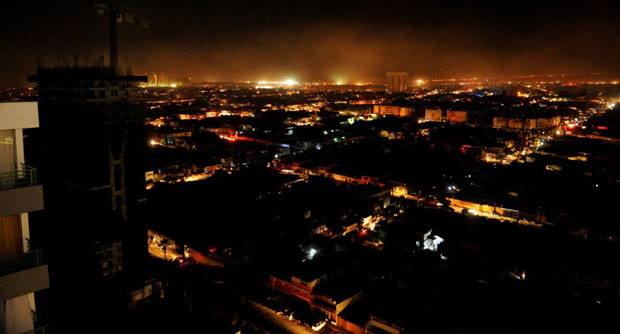
A view of the city of Iquique, Chile, after a powerful earthquake struck late Tuesday, April 1, 2014. AP
SANTIAGO, Chile—A powerful magnitude-8.2 earthquake struck off northern Chile on Tuesday night, setting off a small tsunami that forced evacuations along the country’s entire Pacific coast. Five people were crushed to death or suffered fatal heart attacks, the interior minister said, but Chile apparently escaped major damage or serious casualties.
The shaking loosed landslides that blocked roads, power failed for thousands, an airport was damaged and several businesses caught fire. About 300 inmates escaped from a women’s prison in the city of Iquique, and Chile’s military was sending a planeload of special forces to help police guard against looting.
In the city of Arica, 139 kilometers from the quake’s epicenter, hospitals were treating minor injuries, and some homes made of adobe were destroyed and 90 percent of customers were without power, authorities said.
The quake also shook modern buildings in nearby Peru and in Bolivia’s high altitude capital of La Paz.
Hours later, a tsunami warning remained in effect for northern Chile, but alerts were lifted elsewhere.
Tsunami watch
“We regard the coast line of Chile as still dangerous, so we’re maintaining the warning,” geophysicist Gerard Fryer at the Pacific Tsunami Warning Center told The Associated Press.
Chile’s Emergency Office said its tsunami watch would remain in effect for six more hours, meaning hundreds of thousands of people along the coast would not sleep in their beds. Swimmers and surfers in the US state of Hawaii, thousands of miles away in the Pacific, might see higher waves Wednesday, the warning center said.
The US Geological Survey initially reported the quake at 8.0, but later upgraded the magnitude. It said the quake struck 99 kilometers northwest of Iquique, hitting a region that has been rocked by numerous quakes over the past two weeks.
Psychiatrist Ricardo Yevenes said he was with a patient in Arica when the quake hit. “It quickly began to move the entire office, things were falling,” he told local television. “Almost the whole city is in darkness.”
The quake was so strong that the shaking experienced in Bolivia’s capital about 470 kilometers away was the equivalent of a 4.5-magnitude tremor, authorities there said.
Aftershocks
More than 10 strong aftershocks followed in the first few hours, including a 6.2 tremor. More aftershocks and even a larger quake could not be ruled out, said seismologist Mario Pardo at the University of Chile.
Interior Minister Rodrigo Penailillo said President Michelle Bachelet was closely watching the situation and was ready to take “any measures” to ensure people’s safety. Hundreds of soldiers were being deployed in the quake zone, and a flight would be leaving soon with 100 special forces on board, he added.
“We have taken action to ensure public order in the case of Iquique, where we’ve had a massive escape of more than 300 female prisoners from the Iquique jail, so that the armed forces and police can coordinate and provide tranquility and security to the residents,” he said.
Some roads in northern Chile were blocked by landslides, causing traffic jams among people leaving the coast. But coastal residents remained calm as they head inland while waves measuring almost 2 meters (6 ½ feet) struck their cities.
People embrace on the upper floor of an apartment building located a few blocks from the coast where they gathered to avoid a possible tsunami after an earthquake in Iquique, Chile, Tuesday, April 1, 2014. AP
Evacuations also were ordered in Peru, where waves 2 meters above normal forced about 200 people to leave the seaside town of Boca del Rio. But there were no injuries or major damage, said Col. Enrique Blanco, the regional police chief in Tacna, a Peruvian city of 300,000 near the Chilean border. “The lights went out briefly, but were re-established,” Blanco said.
Quake prone
Chile is one of the world’s most earthquake-prone countries because just off the coast, the Nazca tectonic plate plunges beneath the South American plate, pushing the towering Andes cordillera to ever-higher altitudes.
The latest activity began with a strong magnitude-6.7 quake on March 16 that caused more than 100,000 people to briefly evacuate low-lying areas. Hundreds of smaller quakes followed in the weeks since, keeping people on edge as scientists said there was no way to tell if the unusual string of tremors was a harbinger of an impending disaster.
The last recorded big quake to hit far northern Chile around Iquique was a devastating magnitude-8.3 in 1877. It unleashed a 24-meter-high (nearly 80-foot-high) tsunami, causing major damage along the Chile-Peru coast and fatalities as far away as Hawaii and Japan.
A magnitude-8.8 quake and ensuing tsunami in central Chile in 2010 killed more than 500 people, destroyed 220,000 homes, and washed away docks, riverfronts and seaside resorts. That quake released so much energy, it actually it shortened the Earth’s day by a fraction of a second by changing the planet’s rotation.
The strongest earthquake ever recorded on Earth also happened in Chile — a magnitude-9.5 tremor in 1960 that killed more than 5,000 people.
Chile is the world’s leading copper producing nation, and most of its mining industry is in the northern regions. Top mining companies said there was no serious damage to their operations so far.
RELATED STORIES
Tsunami warning raised after 8.0-magnitude quake hits Chile
Strong quake strikes off Chile